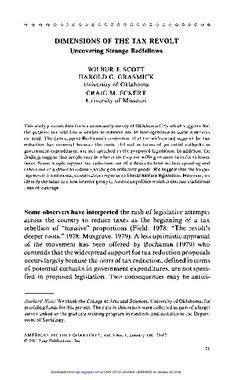| dc.contributor.author | Wilbur J. Scott | |
| dc.contributor.author | Harold G. Grasmick | |
| dc.contributor.author | Craig M. Eckert | |
| dc.date.accessioned | 2016-01-14T19:53:43Z | |
| dc.date.accessioned | 2016-03-30T15:33:09Z | |
| dc.date.available | 2016-01-14T19:53:43Z | |
| dc.date.available | 2016-03-30T15:33:09Z | |
| dc.date.issued | 1981-01-01 | |
| dc.identifier.citation | Scott, W. J., Grasmick, H. G., & Eckert, C. M. (1981). Dimensions of the Tax Revolt: Uncovering Strange Bedfellows. American Politics Research, 9(1), 71-87. doi: 10.1177/1532673x8100900104 | en_US |
| dc.identifier.uri | https://hdl.handle.net/11244/25410 | |
| dc.description.abstract | This study presents data from a community survey of Oklahoma City which suggests that the putative tax rebellion is neither as massive nor as homogeneous as some observers contend. The data support Buchanan's contention that the widespread support for tax reduction has occurred because the costs, defined in terms of potential cutbacks in government expenditures, are not specified in the proposed legislation. In addition, the findings suggest that people vary in what costs they are willing to incur in order to lower taxes. Some people support tax reduction out of a desire to limit welfare spending and others out of a desire to reduce spending on collective goods. We suggest that the former represents a traditional, conservative response to liberal welfare legislation. However, we identify the latter as a new interest group in American politics which cross-cuts traditional lines of cleavage. | en_US |
| dc.language.iso | en_US | en_US |
| dc.publisher | American Politics Research | |
| dc.title | Dimensions of the Tax Revolt: Uncovering Strange Bedfellows | en_US |
| dc.type | Research Article | en_US |
| dc.description.peerreview | Yes | en_US |
| dc.description.peerreviewnotes | https://us.sagepub.com/en-us/nam/manuscript-submission-guidelines | en_US |
| dc.identifier.doi | 10.1177/1532673x8100900104 | en_US |
| dc.rights.requestable | false | en_US |
